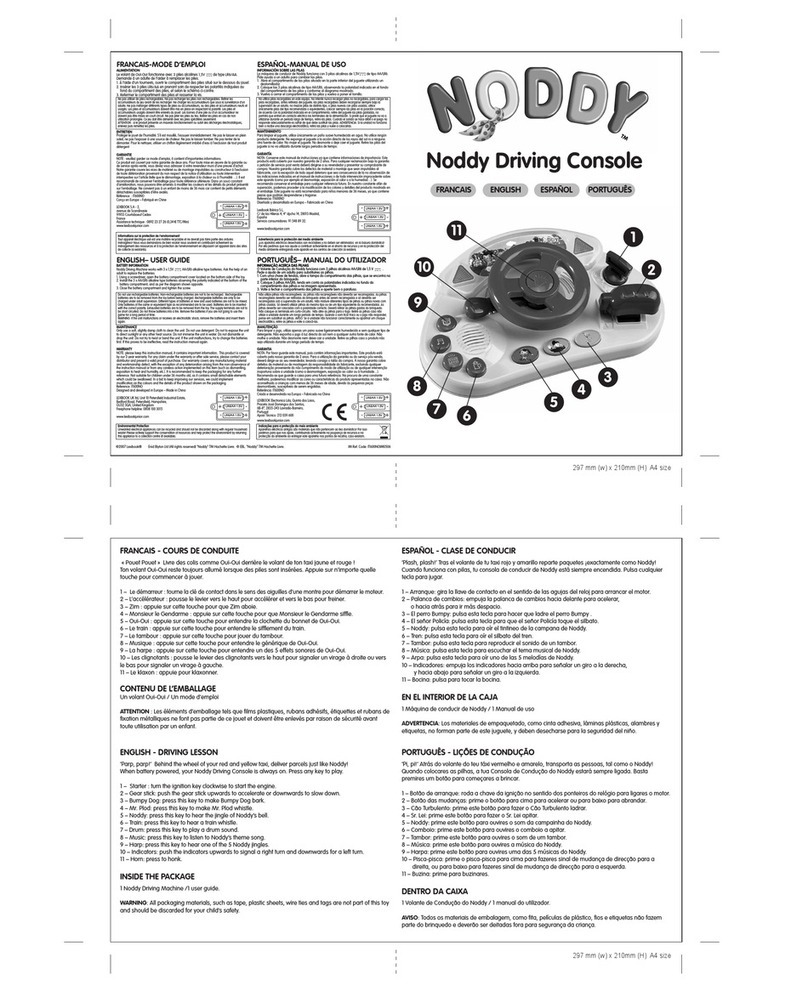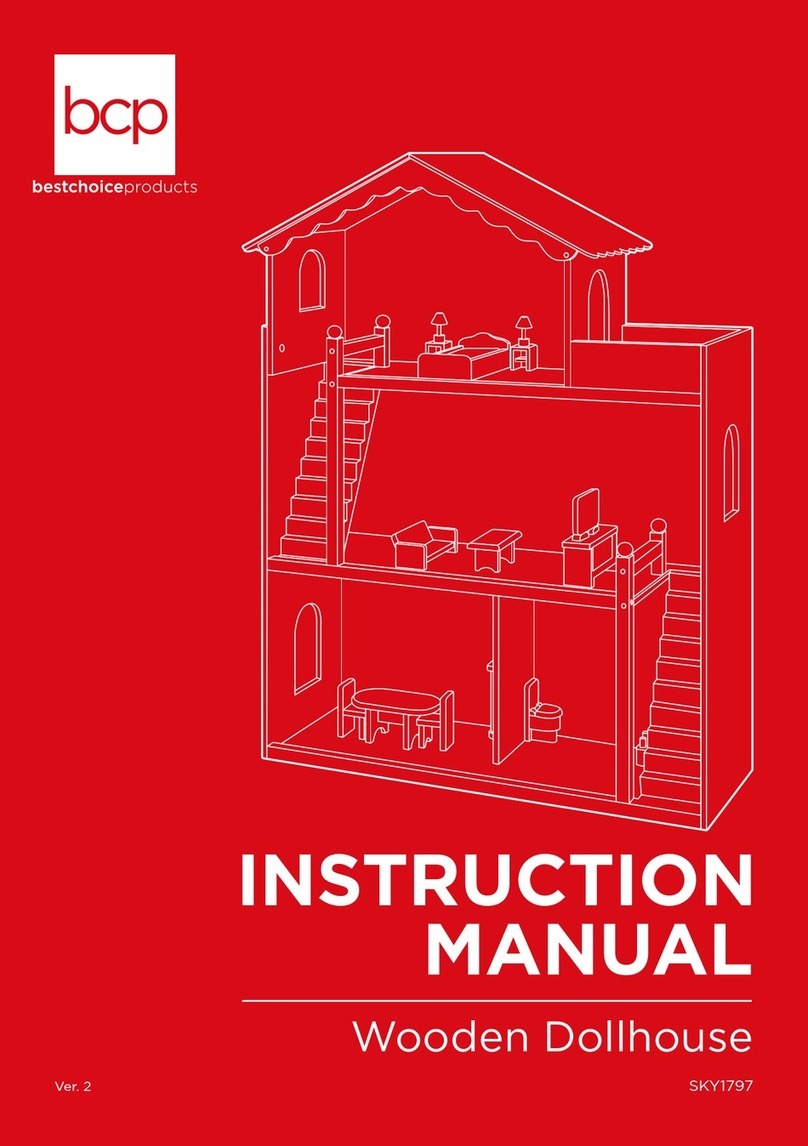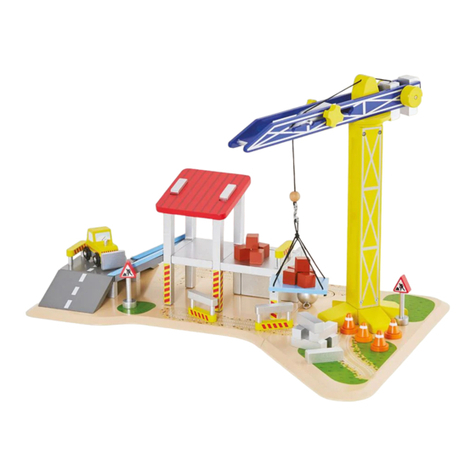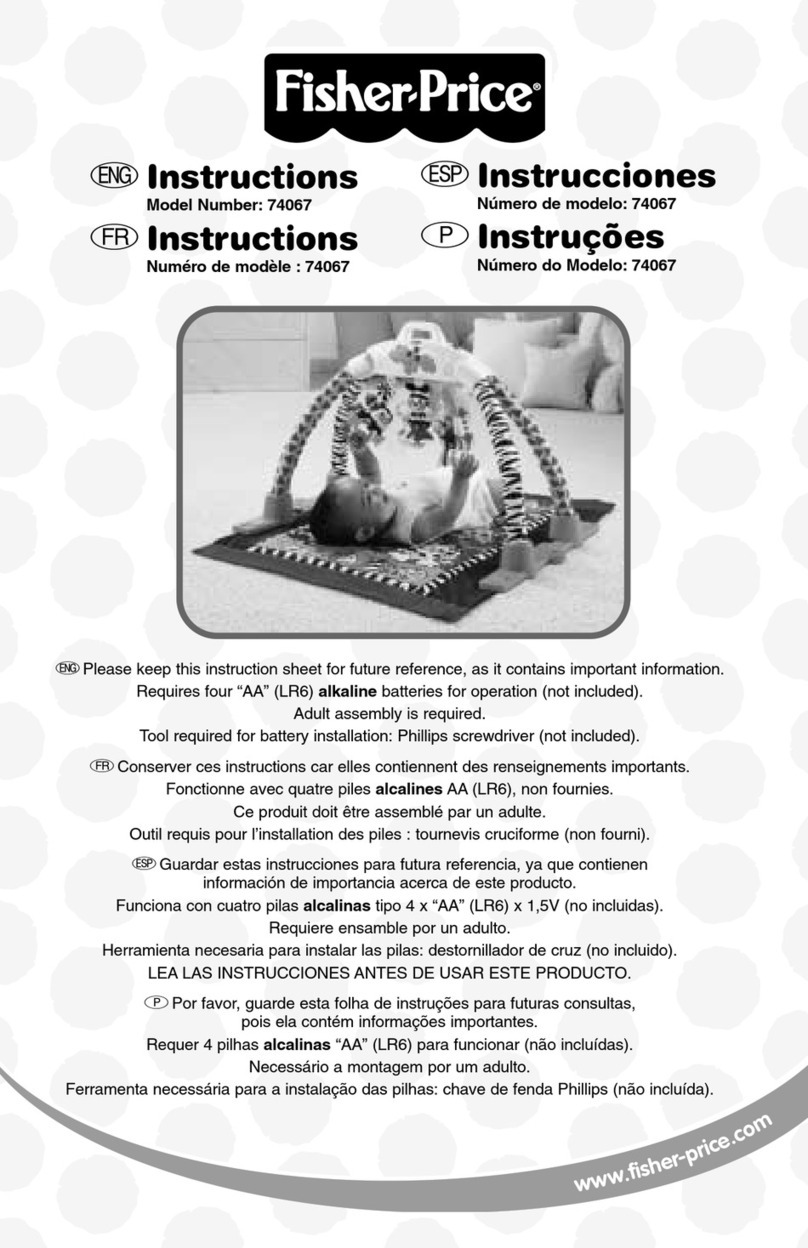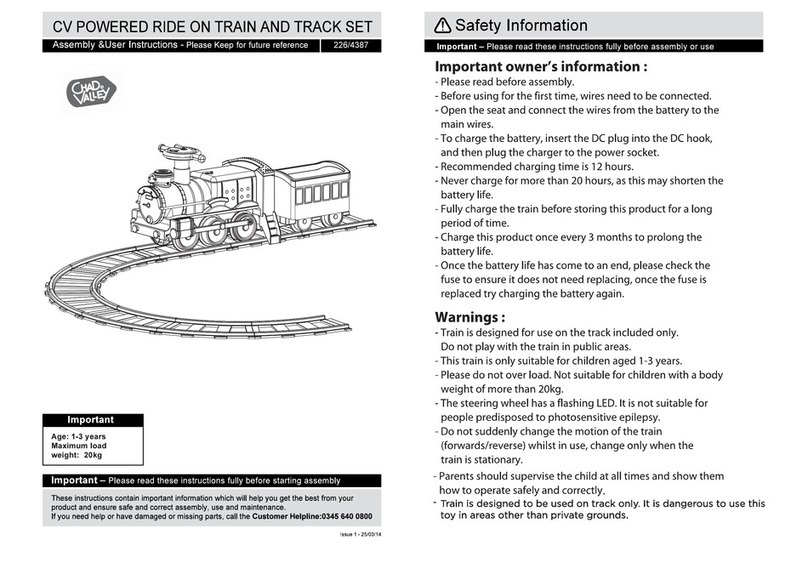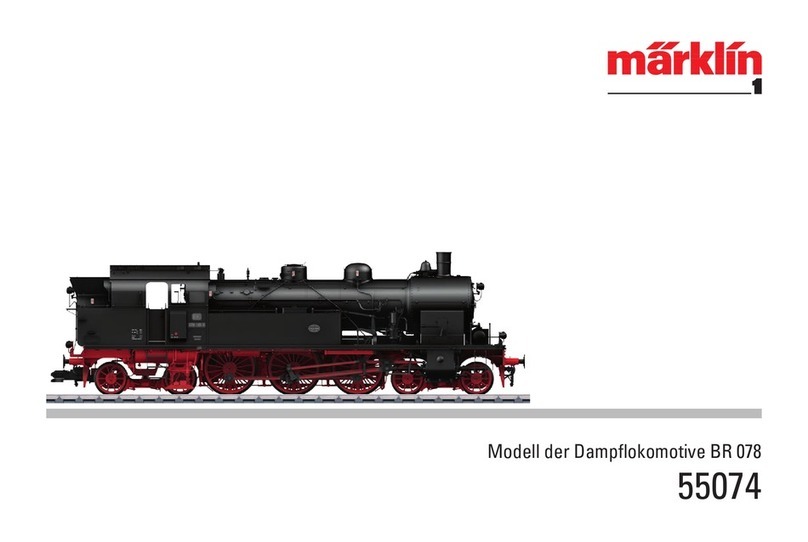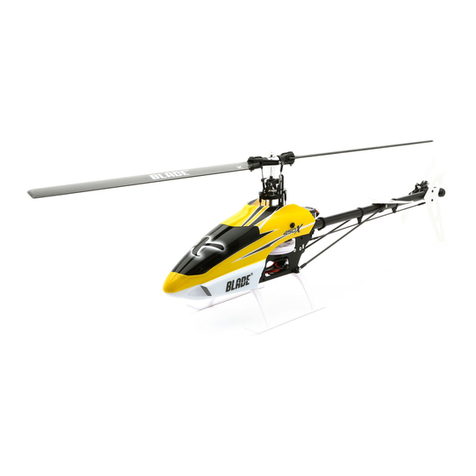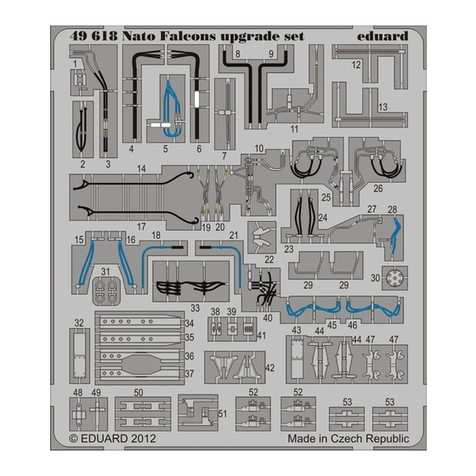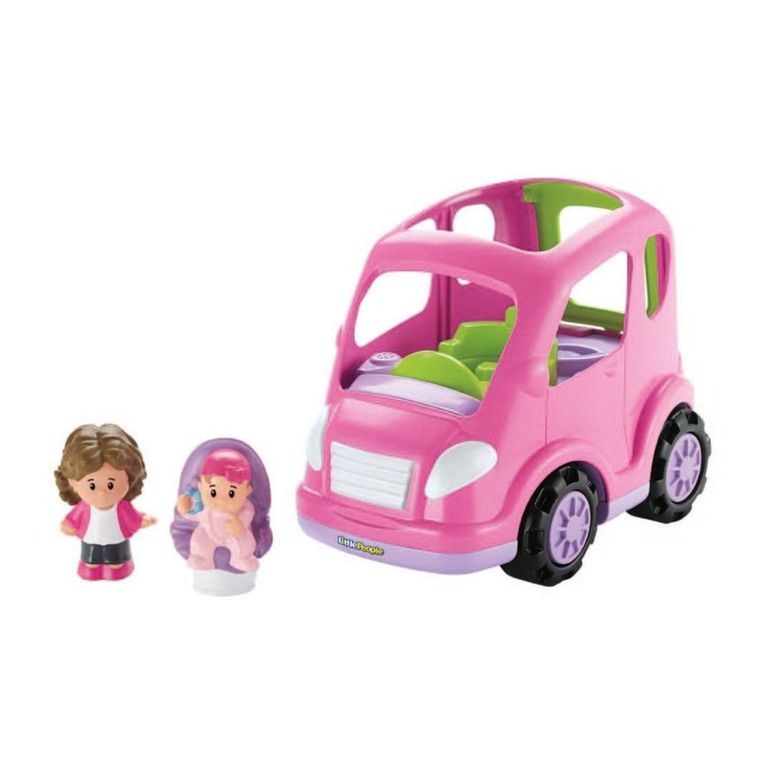Athearn Genesis SD45-2 Manual

*Note- The Bell [F1] Dynamic Brake [F6] and
Rail-Wheel Clack [F10] can not be played
simultaneously-the Bell sound will interrupt the
other two sounds.
*Note- Because this locomotive has a dual
function sound decoder on-board, it does not
support CV read back features.
This decoder supports all program methods
including: register mode, paged mode, CV pro-
gramming mode, direct mode, and program-
ming on the mainv [OPS mode programming].
Program the locomotive the same way you
would program any other NMRA compatible
decoder with your DCC system.
Out Of The Box DCC Running
The first time you run your new SD45-2 loco-
motive there are a few steps you should take
to make sure the locomotive operates properly:
Test the locomotive in it’s analog mode
[D.C.] if possible. If it runs properly [lights,
sound, forward and reverse] on D.C., it will
run trouble free on DCC.
The locomotive comes with a factory de-
fault DCC address of #3. Before program-
ming a new address into the locomotive,
test run it on your DCC system on address
#3. This will also insure there are no prob-
lems with the locomotive.
Test all functions [lights and sound] on
default address of #3. Use the supplied
Function Chart.
To avoid a current overload on your DCC
system when starting it up with a lot of sound
equipped locomotives on your layout, your new
Athearn Genesis SD45-2 locomotive does not
automatically start up in the DCC mode. To
start the locomotive, in Run Mode, enter the
address you have assigned for the locomotive,
then press any function button [F1-F9] two
times (do not press F0 2 times or you will shut
off the sound). You will then hear the locomotive
go through it’s start up procedure [there will be
no movement or operating functions for a few
seconds until the locomotive’s idle steadies
out]. Once your locomotive finishes it’s start up,
it is ready to go to work on your layout.
When you are finished running your locomotive,
pressing function button 8 [F8] four times will
shut your locomotive down. When the locomo-
tive is shut down this way, it will not automati-
cally start up next time you need it. You will
have to press any function button 2 times to
re-start it.
Once these steps have been completed, fol-
low the included CV chart to program any new
programming features you want into the loco-
motive. When you initially program your new
SD45-2 locomotive, this step should be done
on a program track for best results. You must
know how to properly use your DCC systems
programming mode to program any decoder. If
you are unsure of programming a decoder with
your system, please consult your DCC systems
instruction book regarding programming or
contact the manufacturer of your DCC system
for proper guidance.
1.
2.
3.
FACTORY
VALUE
RANGECV REGISTER
Short address
R1 1-127 3CV1
Start voltage
R2 0-32 0CV2
Acceleration
R3 0-32 0CV3
Deceleration
R4 0-32 0CV4
Top voltage
- 0-32 32CV5
Speed curve select (0=linear, 1=slow
increase at slow speed, 2=fast increase
at slow speed)
CV6
Basic configuration
R5
R6
-
- -
Page number
-- -
2CV29
Manufacturer Version #
R7 - 32CV7
Manufacturer I.D.
R8 - 143CV8
Long address upper byte
- 192-231 192CV17
Long address lower byte
- 0-255 3CV18
Advance consist address
-
-
-
-
-
0-127
-
0CV19
When CV-21=0, all accessory functions will follow
its own address. When CV-21=1, all functions
will follow the consist address
0CV21
Horn type 0-14 4CV50
Sound on/off (0=off) 0-1 1CV49
Horn volume 0-3 3CV51
Bell type
-
-
-
0-6 3CV52
Bell volume 0-7 3CV53
Bell ring rate 0-50 3CV54
Diesel rumble volume
- 0-3 3CV55
Brake squeal volume
-
-
-
-
-
-
-
-
-
0-3 3CV56
Dynamic brake volume 0-3 3CV57
Air release volume 0-3 3CV58
Air pump volume 0-3 3CV59
Safety pop valve volume 0-3 3CV60
Engine cooling fan volume 0-3 3CV61
Coupling volume 0-3 3CV62
Random noise volume 0-3 3CV63
Rail wheel clack 0-3 3CV64
User identification number
- 0-255 0CV105
User identification number
-
-
-
-
-
-
-
0-255 0CV106
Light effects see chart 0CV112
Coupling fire volume 0-3 3CV113
Brake release volume see chart 0CV114
Auto brake squeal enable/disable 0-1 1 (enable)CV115
Coupling sound type 0-2 (0 is off) 1CV116
Random sound enable 0-1 1 (enable)CV118
-Ditch light flash rate 0-10 3CV120
Diesel sound type (0=off, 1=rpm & notch synchro
to speed, 2=linear rpm synchro to speed, 3=notch
up/down) ( F8=notch down, F9=notch up)
-0-3 1
CV122
Factory default setting: Programming to 1 will
restore all CV’s to default setting
-- 0
CV125
DESCRIPTION
Programming for DCC Operation – Digital Mode
This decoder supports all program methods including register mode, paged mode, CV programming, direct mode
and programming on the main (OPS mode programming). Program the locomotive the same way you would pro-
gram any other NMRA compatible decoder with your DCC system.
Note: Due to the nature of dual function decoders, it does not support the CV read back feature.
The Dual-Function decoder is manufactured by Model Rectifier Corporation for Athearn Trains.
1550 Glenn Curtiss Street
Carson, CA 90746
www.athearn.com
©2006 Horizon Hobby, Inc., Champaign, IL.
G101 04/14/06
GENESIS SD45-2
WITH DC/DCC
SOUND SYSTEM

Genesis SD45-2 Locomotive Instruction Guide
Your new Genesis SD45-2 Diesel Locomotive
comes factory equipped with a state-of-the-art
Dual Function decoder. This enables your loco-
motive to operate with any NMRA compatible
DCC system, as well as with any regular DC
Train Control [HO power pack]. It will automati-
cally sense the type of control you are using
without you having to set it up for the required
operation.
Caution: Do not run your new Genesis SD45-2
Diesel Locomotive with power packs intended
for “G” scale [do not exceed 18 VDC] as you
may damage the locomotive circuitry. Also,
never operate your locomotive with a trans-
former designed for use with AC powered
model trains [such as O-27 trains or some
European HO models].
Some DCC systems also come equipped with
a switch for extra voltage for larger scales
[“O” or “G”]. If you use your locomotive on
this setting damage will occur to the on-board
electronics due to the higher constant track
voltage [22 volts].
DC Operation- Analog Mode
The wireless remote transmitter [included] is
powered by a 12 volt battery [#A23.12].
One battery is included, replacement batter-
ies are readily available at electronic or office
supply stores.
There are certain conditions that will affect the
range of the transmitter [atmospheric, metal
piping, any type of metal screening used on
the layout, etc.]. For best operation it is advis-
able to place the transmitter antenna close to
the rails as you operate your locomotive.
This model will operate with a standard analog
DC power pack. However, the locomotive’s
sound will not begin until the throttle is at
approximately 50% of the throttle setting. The
locomotive will begin moving when the throttle
has been turned about 60%. The wireless
remote transmitter features six buttons that
control various sounds:
Button 1 will start or stop the bell ringing.
Button 2 will blow the air horn – the length of
time the button is held determines the length
of the horn blast.
Button 3 activates the sound of couplers con-
necting.
Button 4 controls the brake release sound
(when the engine is in idle) or brake squeal
(when the train is moving).
Button 5 turns the dynamic brake sounds on
and off.*
Button 6 allows you to turn off the headlight,
useful for when a locomotive is in idle.
*Dynamic Brake Sound- [Analog D.C. or DCC
Operation]:
When the dynamic brake sound is turned off,
there will be an approximate delay of 2 seconds
while the sound fades. [Pressing the button
again before the sound fades will reactivate the
dynamic brake sound unnecessarily.] Note that
the dynamic brake sound cannot be operated
while the bell sound [button 1] is ringing.
A unique feature of the dynamic brake sound
is that when activated the diesel prime mover
sound will automatically notch down to the idle
setting. This is true to life, as the engineer of a
real locomotive will put the prime mover into
idle when the dynamic brakes are activated.
This does not affect the speed of your locomo-
tive, but you can use your throttle to slow the
locomotive as it would in real life. When the
dynamic brake is deactivated the prime mover
sound automatically notches back up to your
present throttle setting.
•
•
•
•
•
•
Programming - Analog Mode
To program the various sounds, please follow
the following steps:
Turn on the power pack. Move the throttle
slowly up until you hear the prime mover
sounds start, make sure the loco is in idle.
Turn off the power switch [leaving the
throttle setting as is] and wait 2 seconds.
Press and hold Button #6 while you turn
the power switch to ON. When you hear the
locomotive say “Program” quickly release
Button #6, wait 5 seconds before pressing
any other buttons. Note: Program Mode is a
slow process. Always wait 2 seconds after
pressing a button. Do not press two buttons
within that 2 second lag time, and do not
press and hold a button while in the Pro-
gram Mode, as the circuitry
may “read” that as the button being
pressed twice, causing an error. While in
the Program Mode you will only be able to
perform approximately 30 program opera-
tions.
To return to the Run Mode, turn the power
pack’s ON/OFF switch to off, then wait 2
seconds before turning the power pack
back on.
While in the Program Mode, press Button
#1 to change the bell type- there are eight
types, plus“OFF” from which to choose,
and you will hear a sample of each bell
type ring four times each time Button #1
is pressed. After you hear the bell type you
like, or “OFF”, stop pressing Button #1.
Utilize Button #2
to choose from 15 different
air horn sounds plus “OFF”. Each time you
press Button #2 you will hear a sample of
the horn sound, stop pressing Button #2
when you hear the horn sound you desire or
“OFF”.
Button #3 turns the coupling sound “ON”
[sound heard] or “OFF”.
Button #4 can be used to alter the rate at
which the bell will ring.
Button #5 is used to turn all lights on or off.
While in the Program Mode, press Button
#5 once, you will hear the locomotive say
“Program”. This confirms that when you
re-enter the Run Mode the lights will be
off. To turn the lights back on, re-enter the
Program Mode, press Button #5 and again
the locomotive will say “Program”. This
will confirm that when you re-enter the Run
Mode, the lights will be turned on.
The “OFF” features are useful when the lo-
comotive is a trailing unit in a multiple unit
consist, and only the leading locomotive’s
lights and accessory sounds are needed to
be activated by the remote transmitter.
Program Sound Volumes
In the Program Mode you may individually ad-
just the volume of 5 sounds [Buttons 1 through
5]. To adjust the volume, press Button #6
[you will hear the locomotive say “Program”]
and then select one of the sounds [Buttons 1
through 5]. Each sound has four volume level
settings. For example, to adjust the volume of
the bell, press Button #6 [you will hear “Pro-
gram”] wait 2 seconds and then press Button
#1. At this point, you will hear a sample of the
bell sound in order to judge the volume. Repeat
pressing Button #6 and, two seconds later, But-
ton #1 to hear the next volume level, stopping
when the desired volume level is heard.
1.
2.
3.
4.
•
•
•
•
•
•
Note- There is a manual volume pot located
on the top of the circuit board. The adjustment
is set from the factory at full. To lower the
volume manually, use a small screwdriver and
turn the pot slowly clockwise until the desired
volume is obtained. There is no “stop” posi-
tion on the pot. If you continue turning the pot
clockwise, the sound will completely shut off,
then go back to full volume.
Restoring Factory Defaults
In the Program Mode, press Button #6 five
times [press, wait for “program”, wait 2 sec-
onds, press Button #6 again, listen for “pro-
gram”, etc.].
Once done the locomotive will go into it’s start-
up mode and be ready to run when the throttle
is advanced.
Programming –DCC Mode
Your Genesis SD45-2 Locomotive will operate
on any NMRA compatible Digital Command
Control [DCC] system. The highly advanced
dual-function decoder has the following fea-
tures:
Synchronized diesel engine sound with as-
sociated random locomotive sounds.
1.5 amp capacity.
Programmable for either 2 digit [1-127] or
4 digit [1-9999] addresses.
Programmable start voltage.
Programmable acceleration rate.
Programmable deceleration rate.
FUNCTION
Double click F0 Turns ON/OFF sound
Bell ON/OFF
Horn
Turns ON/OFF accesory lighting
Coupling
Brake release (idle) / Brake squeal (moving)
Dynamic Brake ON/OFF
Air hose firing/uncoupling lever
Double click will shut down
Engine cooling fan
Rail wheel clack (only moving)
Traction air compressor
Turns ON/OFF sound
Short air release
Coupling crash
Air pump
Associated locomotive sound
Flange noise
Change bell type
Horn type select
*Note 1: Only MRC Prodigy Advance DCC has F13-F19 accessory functions
*Note 2: When CV122=3 (manual notch up/down, F8 will notch down and
F9 will notch up)
F1
F2
F3
F4
F5
F6
F7
F8
F9
F10
F11
F12
F13*
F14*
F15*
F16*
F17*
F18*
F19*
IDLE/MOVING
Operation- DCC Sounds Chart
•
•
•
•
•
•
Programmable top voltage.
Programmable 14-28/128 speed steps.
Directional lighting {F0}.
Special lighting effects as per road name
[either ditch lights, gyralights, xenon
strobes or prime strato lights].
16 accessory sound functions.
Advanced consisting [CV 19].
OPS Mode programming.
Compatible with NMRA DCC standards.
Complies with Part 15 of FCC regulations.
Programmable individual sound volumes.
*NOTE- Some DCC systems do not have
enough power on the Program Track for pro-
gramming sound decoders. If your systems is
one of these, there are Program track Boosters
available from aftermarket DCC suppliers.
•
•
•
•
•
•
•
•
•
•
Other manuals for Genesis SD45-2
1
Other Athearn Toy manuals








